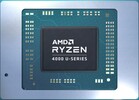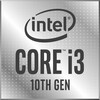AMD Ryzen 7 4980U vs Intel Core i3-1005G1 vs AMD Ryzen 5 4600U
AMD Ryzen 7 4980U
► remove from comparison
The AMD Ryzen 7 4980U is a Renoir family processor designed for certain Microsoft Surface systems. 4980U has eight Zen 2 cores clocked at 2.0 GHz (base clock speed) to 4.4 GHz (Boost) with thread-doubling SMT tech enabled for a total of 16 threads. The chip is manufactured on the modern 7 nm TSMC process and partly thanks to that AMD promises a 2x improvement in performance-per-Watt over Ryzen 3000 series mobile CPUs.
Architecture
The Zen 2 microarchitecture has brought a sizeable per-thread performance boost compared to the outgoing Zen+ parts. Renoir product family is also the first to introduce 8-core ULV processors to laptop market, keeping power consumption within reasonable limits. This AMD processor family is very impressive from most perspectives. One of the disatvantages to keep in mind is the lack of PCI-Express 4 support, meaning these blazing-fast NVMe SSDs will be limited to 3.9 GB/s tops.
Ryzen 7 4980U is designed to work with quad-channel LPDDR4 memory at up to 4,267 MHz. 8 MB of Level 3 are present in this chip. The Ryzen 7 gets soldered straight to the motherboard (FP6 socket) and is thus not user-replaceable. Please go to our Renoir hub page for more information on the product family.
Performance
The 4980U is the fastest U-class Ryzen 4000 series chip. As such, its clock speeds are 200 MHz higher (both the base one and Boost one) than what the Ryzen 7 4800U has.
It is thus hardly surprising that the average 4980U in our database is in the same league as the Ryzen 7 5800U and also the Core i7-1260P, as far as multi-thread benchmark scores are concerned.
Graphics
In addition to its eight CPU cores, the Ryzen 7 also features the Radeon RX Vega 8 graphics adapter with 8 CUs (= 512 shaders) at up to 1,950 MHz. This iGPU is compatible with FreeSync and DirectX 12 and is able to HW-decode AVC, HEVC, VP9-encoded videos (no AV1 support here). Vega 8 is capable of outputting UHD 2160p60 video signal to several monitors and, similar to Intel's Iris Xe (80 EUs), is good enough for a bit of light gaming on the go, provided one is content with sub-1080p resolutions and low/medium quailty presets.
Power consumption
The APU has a default TDP, also known as the long-term power limit, of 15 W; much like it is with other U-class Ryzen 4000 chips, AMD is fine with laptop makers (Microsoft, in this case) changing that value to anything between 10 W and 25 W.
The 7 nm TSMC process this Ryzen 7 is built with makes for above average, as of mid 2022, energy efficiency.
Intel Core i3-1005G1
► remove from comparison
The Intel Core i3-1005G1 is a low-power, Ice Lake family processor (SoC) featuring 2 cores, 4 threads, 4 MB of L3 cache and the UHD G1 (32 EUs) iGPU. It saw the light of day in 2019. The chip is designed for use in highly portable laptops of the more affordable flavour; the CPU cores run at 1.2 GHz to 3.4 GHz which is not a lot.
Architecture & Features
Ice Lake family chips are powered by Sunny Cove CPU cores.The latter aim to do what Palm Cove cores (that we never really got a chance to get a taste of) were expected to do, delivering a double-digit IPC uplift over the venerable Skylake architecture thanks to a range of small improvements across the board including scheduler improvements, larger caches and buffers, and support for new instruction sets.
Thunderbolt 3 support is built right into the Core i3 (meaning it has several PCIe 3 lanes exclusive to Thunderbolt devices, reducing the number of additional components required for Thunderbolt to work) and so is Intel CNVi Wi-Fi 6 support (making it easier for Intel to sell its proprietary WLAN cards to laptop makers). The Core i3-1005G1 also has the DL Boost and GNA features for applications centered around machine learning.
The 4 GT/s bus is indicative of a consumer-grade chip, since CPUs for gaming laptops and portable workstations usually employ the faster 8 GT/s bus. RAM support is nothing to sneeze at, at up to DDR4-3200 or LPDDR4-3733. NVMe SSDs are supported, with data transfer rates limited to 3.9 GB/s (this is what four PCIe 3 lanes are good for). SATA drives and even eMMC chips are also natively supported here.
This is not a user-replaceable CPU, as it gets permanently soldered to the motherboard (BGA1526 socket interface).
OS support is limited to 64-bit Windows 10 and 64-bit Windows 11, as well as many Linux distros.
Performance
The average 1005G1 in our database is a disappointment, its multi-thread benchmark scores only matching those of Intel's Core i5-7267U and AMD's Ryzen 3 2300U. This is unfortunately in line with what we've been seeing from other Ice Lake family processors; they tend to be held back by their comparatively low clock speeds. While not as slow as many Celerons and Pentiums, this Core i3 will still look out of place in anything but the most affordable laptops and mini-PCs.
With its long-term CPU power limit of 25 W, the Lenovo V17-IIL 82GX008TGE is among the fastest laptops built around this Core i3 that we know of.
Graphics
The Core i3-1005G1 features the UHD Graphics G1 (32 EUs) graphics adapter running at up to 900 MHz. This DX12-compatible iGPU is not much faster than the dated UHD 620 graphics solution, making it almost useless to gamers, and there are no cutting-edge features such as ray tracing support to be found here, either. The list of supported resolutions tops out at 5120 x 3200, and there is no hardware AV1 codec support meaning such a video will be SW-decoded with rather low energy efficiency. The usual HEVC, AVC and VP9 options are supported, thankfully.
The G1 will drive up to 3 monitors simultaneously, provided the system has the outputs required. Higher-end Ice Lake chips are equipped with the G4 (48 EUs) or the G7 (64 EUs) adapters that are significantly faster.
Power consumption
The Core i3 has a 15 W default TDP (also known as the long-term power limit), a value that laptop makers are allowed to reduce slightly - 13 W being the lower limit - resulting in lower clock speeds and lower performance. Either way, that's a tad too high to allow for passively cooled designs.
The SoC is built with Intel's second-gen 10 nm process (not "10 nm SuperFin" or "Intel 7") for average, as of late 2022, energy efficiency.
AMD Ryzen 5 4600U
► remove from comparison
The AMD Ryzen 5 4600U is a processor for thin and light laptops based on the Renoir architecture. The 4600U integrates six cores based on the Zen 2 microarchitecture. They are clocked at 2.1 (guaranteed base clock) to 4 GHz (Turbo) with SMT / Hyperthreading support (12 threads). The chip is manufactured in the modern 7 nm process at TSMC and partly thanks to it AMD advertises a 2x improved performance per Watt for the Renoir chips.
With two less cores, the Ryzen 5 4600U is clearly slower than the Ryzen 7 4700U and 4800U in multi threaded workloads. However, it should still beat the fastest 15 Watt Ice Lake Intel Core i7-1065G7 (4 cores, 3.9 GHz). Thanks to the 4 GHz Boost clock, the single core performance should be similar. Therefore, the Ryzen 5 4600U is a very fast 15 Watt CPU and clearly faster than the old Ryzen 7 3700U.
In addition to the six CPU cores, the APU also integrates a Radeon RX Vega 6 integrated graphics card with 6 CUs and up to 1500 MHz. The dual channel memory controller supports DDR4-3200 and energy efficient LPDDR4-4266 RAM. Furthermore, 8 MB level 3 cache can be found on the chip. See our hub page on the Renoir Processors for more information.
The TDP of the APU is specified at 15 Watt (default) and can be configured from 10 to 25 Watt by the laptop vendor. That means the chip is intended for thin and light laptops (but with fans).
| Model | AMD Ryzen 7 4980U | Intel Core i3-1005G1 | AMD Ryzen 5 4600U | ||||||||||||||||||||||||||||||||||||||||||||||||||||||||||||||||||||||||||||||||
| Series | AMD Renoir (Ryzen 4000 APU) | Intel Ice Lake | AMD Renoir (Ryzen 4000 APU) | ||||||||||||||||||||||||||||||||||||||||||||||||||||||||||||||||||||||||||||||||
| Codename | Renoir-U (Zen 2) | Ice Lake-U | Renoir-U (Zen 2) | ||||||||||||||||||||||||||||||||||||||||||||||||||||||||||||||||||||||||||||||||
| Series: Renoir (Ryzen 4000 APU) Renoir-U (Zen 2) |
|
|
| ||||||||||||||||||||||||||||||||||||||||||||||||||||||||||||||||||||||||||||||||
| Clock | 2000 - 4400 MHz | 1200 - 3400 MHz | 2100 - 4000 MHz | ||||||||||||||||||||||||||||||||||||||||||||||||||||||||||||||||||||||||||||||||
| L1 Cache | 512 KB | 96 KB | 384 KB | ||||||||||||||||||||||||||||||||||||||||||||||||||||||||||||||||||||||||||||||||
| L2 Cache | 4 MB | 1 MB | 3 MB | ||||||||||||||||||||||||||||||||||||||||||||||||||||||||||||||||||||||||||||||||
| L3 Cache | 8 MB | 4 MB | 8 MB | ||||||||||||||||||||||||||||||||||||||||||||||||||||||||||||||||||||||||||||||||
| Cores / Threads | 8 / 16 | 2 / 4 | 6 / 12 | ||||||||||||||||||||||||||||||||||||||||||||||||||||||||||||||||||||||||||||||||
| TDP | 15 Watt | 15 Watt | 15 Watt | ||||||||||||||||||||||||||||||||||||||||||||||||||||||||||||||||||||||||||||||||
| Technology | 7 nm | 10 nm | 7 nm | ||||||||||||||||||||||||||||||||||||||||||||||||||||||||||||||||||||||||||||||||
| max. Temp. | 105 °C | 100 °C | 105 °C | ||||||||||||||||||||||||||||||||||||||||||||||||||||||||||||||||||||||||||||||||
| Socket | FP6 | BGA1526 | FP6 | ||||||||||||||||||||||||||||||||||||||||||||||||||||||||||||||||||||||||||||||||
| Features | LPDDR4-4266 RAM, PCIe 3, MMX, SSE, SSE2, SSE3, SSSE3, SSE4A, SSE4.1, SSE4.2, AVX, AVX2, BMI2, ABM, FMA, ADX, SMEP, SMAP, SMT, CPB, AES-NI, RDRAND, RDSEED, SHA | DDR4-3200/LPDDR4-3733 RAM, PCIe 3, 4 GT/s bus, DL Boost, GNA, MMX, SSE, SSE2, SSE3, SSSE3, SSE4.1, SSE4.2, AVX, AVX2, AVX-512, BMI2, ABM, FMA, ADX, VMX, SMEP, SMAP, EIST, TM1, TM2, Hyper-Threading, Turbo, SST, AES-NI, RDRAND, RDSEED, SHA, SGX | DDR4-3200/LPDDR4-4266 RAM, PCIe 3, MMX, SSE, SSE2, SSE3, SSSE3, SSE4A, SSE4.1, SSE4.2, AVX, AVX2, BMI2, ABM, FMA, ADX, SMEP, SMAP, SMT, CPB, AES-NI, RDRAND, RDSEED, SHA, SME | ||||||||||||||||||||||||||||||||||||||||||||||||||||||||||||||||||||||||||||||||
| iGPU | AMD Radeon RX Vega 8 (Ryzen 4000/5000) ( - 1950 MHz) | Intel UHD Graphics G1 (Ice Lake 32 EU) (300 - 900 MHz) | AMD Radeon RX Vega 6 (Ryzen 4000/5000) ( - 1500 MHz) | ||||||||||||||||||||||||||||||||||||||||||||||||||||||||||||||||||||||||||||||||
| Architecture | x86 | x86 | x86 | ||||||||||||||||||||||||||||||||||||||||||||||||||||||||||||||||||||||||||||||||
| Announced | |||||||||||||||||||||||||||||||||||||||||||||||||||||||||||||||||||||||||||||||||||
| Manufacturer | www.amd.com | ark.intel.com | www.amd.com |


 Deutsch
Deutsch English
English Español
Español Français
Français Italiano
Italiano Nederlands
Nederlands Polski
Polski Português
Português Русский
Русский Türkçe
Türkçe Svenska
Svenska Chinese
Chinese Magyar
Magyar